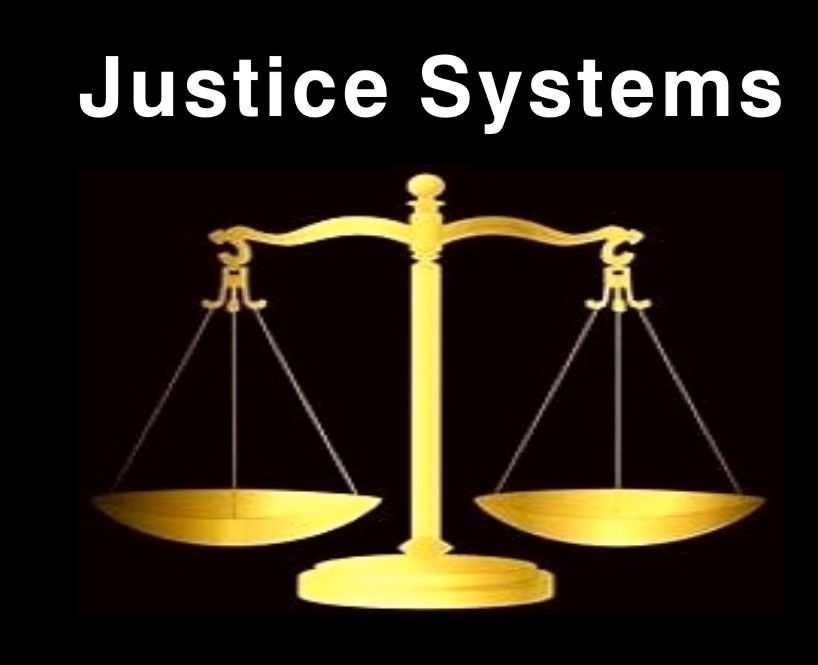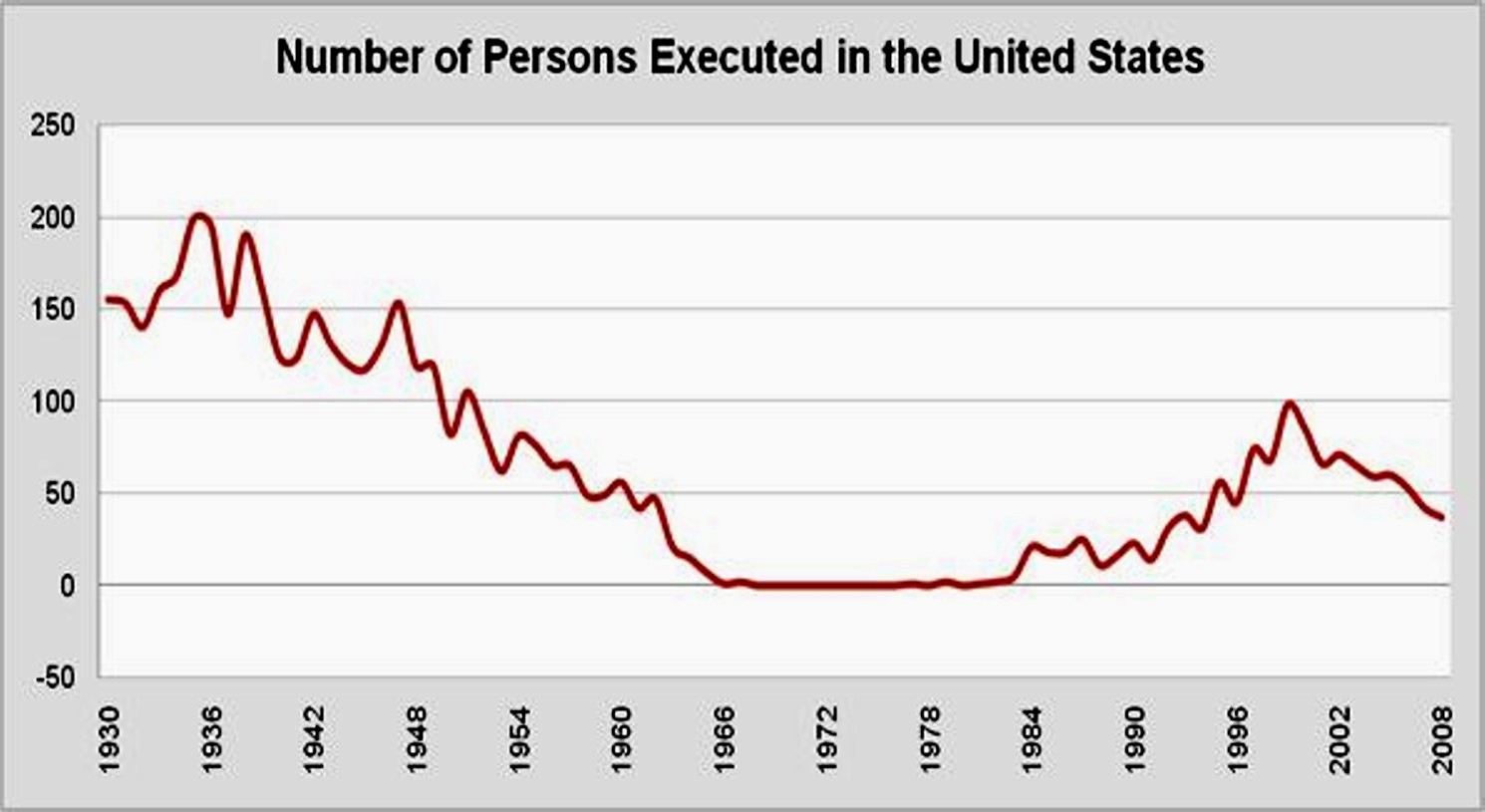
Category: N America context
How The Italian “Justice Tortoise” Is The Likely Winner Compared To For Example the US System
Posted by Peter Quennell
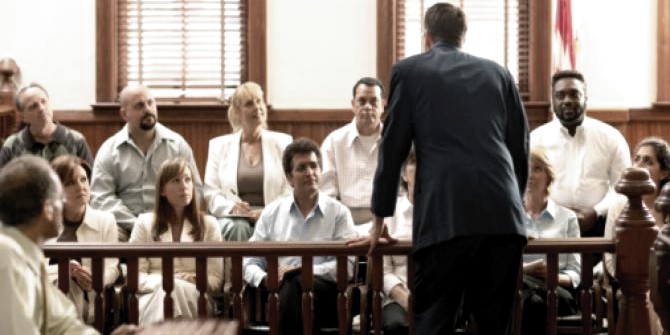
American prosecutor & jury - puzzle now over what system will make them share all evidence
Look around you.
The things you do to make a living. The running of your house and your garden. The education and general development of your children. The restaurants and metro railways and bus services. The police and military and football teams - and grand opera!
All are purposeful systems.
Purposeful systems have created all we have ever built on this planet - all wealth, all structures, all machines, all culture. Typically any educated adult has within them at least 200 significant systems AKA their skill-set: cooking a meal, riding a bicycle, driving a car, using a computer, playing basketball.
You probably dont have a manual for each of them but each time you exercise a skill you probably follow the same hard-learned steps each time you want the benefit obtained previously.
One of the world’s great problems now - starkly seen in the British argument over its future in Europe, and in slow growth in the Arab world (the world’s slowest), and in China’s economy slowing and in anyone without a college degree likely to be worse off going forward - is that we are locked into whole huge arrays of these systems at various levels (family, corporate, city, country, region) that are archaic and mostly quite wrong for our needs going forward.
And few are sure which of all of them add any real value. We are flying blind on a mammoth scale.
With regard to the US as the main economic locomotive, in the 90s two very significant things happened. The East Asia economies really rocketed - because they adopted good systems pioneered by Japan, which itself had started out with many invented in America.
And for a while at least, many Americans really began to “see” systems, and corporations started a huge push toward quality control. You can see one outcome in today’s automobile ads - cars largely sell on their reliability. Their drive systems and safety systems are what sells cars now.
Latest thinking which we often touch on here is that tweaking of any systems anywhere has a short half-life, and after that the only way to get any better is to totally replace them. Go down the road and start over. Jump to the next level through complete reinvention.
After WWII Germany and Japan and Italy of necessity all did that and for most of the time since they really benefited.
But right now, most systems in most countries are archaic and nobody - at least no political leader or candidate - seems to be able to arrive at the vision and technique vital to jumping to the next level. That in fact should really be done mostly bottom-up, with national politicians playing quite a minor role.
“Path dependencies” like the myriad systems of the common market, many very old now, are today at least as deadly to our long-term future as any aliens from other planets.
Italy is working to try to update its justice system right now and we will report on that shortly. At least in theory, it has one of the easiest tasks in the world, because post WWII its legal system was redesigned from the ground up. It had already junked bad aspects, some going back centuries.
Italy already has some of the world’s smartest juries - jury service is compulsory, so smart people cannot dodge them. And the system already has some other very positive things going for it.
Mainly what is needed is some weeding. And such reforms are made easier in Italy because (1) judges and prosecutors all follow career paths and so they are not politically competing with one another; and (2) there is the Council of Magistrates (CSM) which can be very progressive in the reforms it pushes at its level.
Overarching reform in the United States is way way more difficult because power is so diffused in the political system and the political system is so vast, and so split by ideologies, and there is no CSM.
Here is an editorial in the New York Times about curbing the massive damage being done by over-zealous prosecutors - something already taken care of in the Italian system, despite the busload of idiots claiming otherwise.
And here is a blog post calling the New York Times editorial a convoluted crackpot of a column and saying the Times should get real. At least in that way, reform aint ever going to happen.
Hop on a plane, guys. Go to Italy, and learn something.
Another Effective Innovation By New York Police Is Being Duplicated By Others
Posted by Peter Quennell

Police horses, up to a dozen stroked and photographed each evening in the Times Square area
In national US news any innovation of the New York police gets a lot of coverage.
Those crowd-calming police horses seen nightly in the Times Square area go way back, and their presence was never reduced back when some other cities did so - often to their later regret.
There is endemic pressure (especially after 9/11) to keep the city as safe as possible.
From that sustained effort at systems improvement, other American police forces, some very besieged at the moment, attempt to learn something.
New York police both themselves innovate and also adopt good ideas from elsewhere - not least from the brave, popular and effective police forces of Italy.
We posted in January 2013 on New York’s adoption of an Italian approach to policing.
One approach which seems a natural for Italy with all of its art is proving successful in New York now.
Described in the NY Times today is this ongoing exercise in staring at artworks. The point being to sharpen the perceptions of investigators, and to put them all on the same page objectively.
To teach people how to notice details they might otherwise miss, Amy E. Herman, an expert in visual perception, likes to take them to museums and get them to look at the art. Recently she escorted a group of New York City police officers to the Metropolitan Museum of Art and asked them to describe some of the things they saw.
They did their best. “This seems to be a painting of some males with horses,” one officer said of Rosa Bonheur’s mid-19th-century work “The Horse Fair,” a scene of semi-chaos as horses are driven to market. He tried to abide by Ms. Herman’s admonishment to avoid words like “obviously.” “It appears to be daytime, and the horses appear to be traveling from left to right.”
Another pair of officers tackled Picasso’s 1905 “At the Lapin Agile,” which depicts a wilted-looking couple sitting at a French bar after what might have been a long night out. “They appear to have had an altercation,” one observed. The other said, “The male and female look like they’re together, but the male looks like he’ll be sleeping on the couch.”
The officers asked that their names not be used because they were not authorized to speak to reporters. They said that they did not know much about art “” their jobs allow little opportunity for recreational museumgoing “” and Ms. Herman said she preferred it that way.
“I’ve had people say, “˜I hate art,’ and I say, “˜That’s not relevant,’” she said. “This is not a class about Pollock versus Picasso. I’m not teaching you about art today; I’m using art as a new set of data, to help you clear the slate and use the skills you use on the job. My goal when you walk out the door is that you’re thinking differently about the job.”
A painting has many functions. It’s a cultural artifact, an aesthetic object, an insight into a time and a place, a piece of commerce. To Ms. Herman, it’s also an invaluable repository of visual detail that can help shed light on, say, how to approach a murder scene. “It’s extremely evocative and perfect for critical inquiry,” she said in an interview. “What am I seeing here? How do I attach a narrative to it?”
One of the processes:
Before unleashing the officers in the galleries, she talked to them in a classroom in the Met’s basement. She put up a slide of “Mrs. John Winthrop,” a 1773 portrait by John Singleton Copley. The painting, showing a woman sitting at a table holding little pieces of fruit, is considered a masterpiece of fine detail “” the intricacy of the lace trim on the lady’s gown, the rich decorations on her hat. But there’s a detail that’s so obvious, or maybe so seemingly irrelevant, that most people fail to mention it in their description.
“Everyone sees that this is a woman with fruit, and 80 percent miss the mahogany table,” she said. (They also miss the woman’s reflection in the veneer.)
Ms. Herman also displayed a pair of slides featuring reclining nudes: Goya’s “The Nude Maja” (1797-1800) and Lucian Freud’s 1995 “Benefits Supervisor Sleeping,” who is very fat. Ms. Herman asked the group to compare the pictures. “Most cops, when I ask this question, say it shows someone before and after marriage,” she said.
Several officers raised their hands.
“Uh, the woman at the bottom is more generously proportioned,” one said.
“She is morbidly obese,” said another.
“Right!” Ms. Herman said. “Don’t make poor word choices. Think about every word in your communication.”
Ms. Herman, who has a new book out, “Visual Intelligence: Sharpen Your Perception, Change Your Life,” came to her vocation in a roundabout way. She worked first as a lawyer, did not like it, took a job in the development office at the Brooklyn Museum and then moved to the Frick Collection. Earning a master’s degree in art history at night at Hunter College, she eventually became head of the Frick’s education department.
There, inspired by a program in which Yale medical students studied works of art to better observe their patients, she helped devise a similar program for the Frick. Eventually she moved beyond medicine. She has been offering the courses full time as her own business since 2011; her clients include federal and local law enforcement agencies across the country, as well as medical students and business executives.
Also successful elsewhere:
Steve Dye, chief of police at the Grand Prairie Police Department in Texas, brought in Ms. Herman recently to talk to a group of officers from the region. He said her presentation was invaluable in showing the officers how to better observe and document their findings accurately and free from bias.
“Some of the works of art she showed us, we wouldn’t notice the finer details,” he said. “And we’re supposed to be professional observers.”
When forced to deconstruct paintings in group settings, people from different professions tend to respond differently.
For cops it’s a natural.
“The law enforcement community is much more forthcoming,” Ms. Herman said. “Cops will outtalk you every time. Doctors and medical students are much more inhibited. They don’t want to be wrong, and they never want to show that they are ignorant about anything.”
The New York Police Department is one of Ms. Herman’s most important clients. She tailors her presentations to her audiences, and they are on the regular training curriculum at the detective bureau and the training bureau at the Police Academy; other divisions use her services from time to time. In general, her program is voluntary rather than mandatory.
“Amy reminds officers to explore outside the box,” said Police Officer Heather Totoro, who added that the program helped officers in training because of its “uniqueness and power.”
“She taps into officers’ unique sixth sense, teaching them to tell her what they see, not what they think.”
Law enforcement officials tend to view the works through the lens of the job: Who has done what to whom? Where is the perp?
“Sometimes they’ll say, “˜We have an E.D.P. here’ “” an emotionally disturbed person,” Ms. Herman said. Once she showed some officers El Greco’s “The Purification of the Temple,” which depicts Jesus expelling the traders and money-changers amid turmoil and mayhem.
“One cop said, “˜I’d collar the guy in pink’” “” that would be Jesus “” “˜“because it’s clear that he’s causing all the trouble.’”
Among the works she finds most interesting as a learning tool is Vermeer’s exquisitely ambiguous “Mistress and Maid,” a 1666-7 portrait of a lady seated at a table, handing over (or being handed) a mysterious piece of paper. “There are so many different narratives,” she said. “The analysts come away asking more questions than answers “” “˜Who’s asking the question? Who’s doing the talking? Who’s listening?’ The cops will say, “˜It’s a servant asking for the day off.’”
She also likes “House of Fire,” a 1981 painting by James Rosenquist that has three absurdist parts: an upside-down bag of groceries, a bucket under a window shade, and a group of aggressively thrusting lipsticks. “It’s really conducive to good dialogue,” she said. “How many times do officers have to make order out of chaos? So many times in our work we come across things that don’t have a coherent narrative.”
The officers in the class seemed impressed, both by Ms. Herman and by their grand surroundings.
One officer said that she had learned “how to sit down with colleagues and deal with the fact that you can perceive things so differently from each other.” It was her first trip to the Met, or indeed to any art museum.
“I didn’t know what to expect,” she said. “It’s very Thomas Crown-ish, isn’t it?”
Below: the Vermeer painting referred to, in the Frick Museum in New York

Worldwide In 20th Century, Maybe Half Of All Murders May Be Attributed In Part To Lead Poisoning
Posted by Peter Quennell

That lead damages brains has been known for many years. That it causes murders is more recently accepted.
The first graph below shows when the US began to move from leaded gasoline to unleaded gasoline in the mid 70s. Lead was removed altogether around 1990.
Some but not all countries followed a similar pattern.
The effects, though diminishing, are going to be with us for a long time. Maybe to mid-century? The pioneer researcher economist Nick Nevin wrote this about the murder-rate/lead correlation:
Lead exposure trends affect homicide trends with a 21-year time lag, reflecting the impact of early-childhood neurodevelopmental damage when those children reach the peak ages of homicide offending.
That suggests that anyone alive today over 25 may have had significant exposure. Roughly half the world’s population, some 3.5 billion.
Very few of those committed murders, but of those that did the research findings reflected in the second graph below suggest that half might have been lead-affected and there remain among us millions of time-bombs. This is from a recent BBC report:
Dr Bernard Gesch says the data now suggests that lead could account for as much as 90% of the changing crime rate during the 20th Century across all of the world.
Numerous cases like this one now use lead poisoning as a defense. It doesnt seem a get-out-of-jail-free card, but for some obviously mentally impaired it is proving helpful.
How American Judges Can Be Made To Feel The Heat Over Controversial Verdicts
Posted by Peter Quennell

Why American judges can envy Italian judges part deux.
As we surely all know now, most Italian judges advance along a career path. Only a few are politically appointed and none are elected. All of the time their rulings are under minute scrutiny and (as we have seen with Judges Hellmann, Marasca and Bruno) the powerful Council of Magistrates can stop their advancement in a heartbeat if any of those rulings look suspect.
American judges are mostly elected with little training requirements or qualifications testing. If they seem to have stepped out of line some of them can face political hearings and discipline boards (as Judge Heavey did) but not all do.
But the worse reaction many fear more is the media and the public turning upon them, made vastly more possible because of the Internet and happening time and time again these days.
The American judge now much in the news - and not in a good way - is Jean Boyd of Texas.
In March 2012 Jean Boyd, then a Juvenile Court judge, sentenced a 14-year-old black boy to 10 years for killing a smaller boy with one powerful punch. She was criticised for being way too harsh then.
In December 2013 she veered sharply in the other direction.
She sentenced a now notorious teenager to mere probation and rehabilitation after he had killed four people and maimed a fifth for life when drunk-driving. The psychological defense she bought into was that his family was so rich that he grew up without the right parenting.
This was apparently a unique defense and one that has never been attempted for poorer people. Judge Boyd was widely criticised for being way too light then.
The two cases dropped out of the news for a while.
But now the notorious white teenager Ethan Couch is all over the news again. A few weeks ago he was caught on video drinking - which could lead to his serving time in prison - and a couple of weeks ago he disappeared along with his mother.
Considering that he has not yet even been charged with a transgression of his probation, the size and cost of the manhunt was extraordinary. Somehow the US Federal Marshall Service pinpointed his phone in a Mexican apartment, and the Mexican police arrested him along with his mother and locked them up.
Today he is being held in an Mexican prison with his mother. It is just reported that they are fighting extradition.
Good luck with that one.
Judge Boyd actually retired a year ago in face of a petition demanding she be fired. She was given some credit by the local newspaper.
But her verdict never convinced an angry public or the families of the four dead and one maimed victims, and both he and his irresponsible mother also now seem headed for prison.
And it seems Ms Boyd is not returning phone calls.
Below: Tonya Couch and Ethan Couch at the trial in 2013


Counterterrorism: Another Way Italian Law Enforcement Is An Effective Model For Everywhere Else
Posted by Peter Quennell

We have often mentioned these major justice-system pluses:
(1) That Italy has one of the industrialized world’s lowest crime rates and that US cities have been observing its model.
(2) That it has a very prominent and much admired police presence, and a small and much admired court and penal system.
Now Thomas Williams is reporting this third big plus from Rome in Breitbart Business News
A leading military analyst is citing Italy as a model of counterterrorism done right, pointing out that despite many factors going against it, Islamic terrorists have failed to kill a single person on Italian soil.
In the most recent issue of Nikkei Asian Review, Romanian born political scientist and military analyst Edward N. Luttwak lays out a persuasive theory explaining how Italy has been so successful in thwarting Islamic terror attempts. In a word: Italy is not afraid to deport those it considers to be a threat to national security.
In his essay titled “Doing Counterterrorism Right,” Luttwak contrasts Italy with France and Belgium, noting that although Italy is much more vulnerable than they are, it has been far more effective at stopping would-be terrorists before they strike.
So where France has been “caught by surprise again and again by terrorist attacks with many lives lost” and in Belgium “terrorists have been coming and going for years, buying military weapons with remarkable ease,” Italy has remained unscathed.
It would seem that Italy doesn’t have much going for it. It has porous borders and a Muslim population that exceeds 2 million and has played an active role in military expeditions in Islamic territories. Moreover, the Vatican is the “most iconic target in Europe,” and tops the list of objectives of the Islamic State, Luttwak observes. And yet, “nobody has been killed by Muslim terrorists in Italy.”
Italian counterterrorism has been on full alert since 9/11, Luttwak says, and its combined forces “have detected and interrupted hundreds of terrorist plots large and small, at every stage from mere verbal scheming to fully ready actions.”
So where terrorists have successfully attacked in Madrid, London, Paris, Toulouse, Copenhagen, Brussels and elsewhere, in Italy they have been foiled time after time.
Luttwak suggests that Italy’s success is all a question of method, based on the insight that the only thing that can be done to stop potential terrorists is to follow those who are suspected to be truly dangerous around the clock so that they can be arrested or killed at a moment’s notice. Since the numbers of probable suspects can be astronomical, Luttwak says, their numbers must be effectively reduced if this strategy is to bear fruit. And this is exactly what Italy has done.
State intelligence agencies throughout Europe monitor suspects, filling out reports and keeping files, but they often fail to take the action needed. The Italians, however, immediately conduct an interrogation on credible suspects, and many are sent home or arrested, if their situation merits it. Italy currently has more than 180 radical imams in prison, Luttwak notes.
Employing this method, Italian authorities are able to keep numbers of suspected potential terrorists within a reasonable range and thus are able to monitor them effectively.
Earlier this month, Franco Roberti, the head of Italy’s anti-mafia and counterterrorism task force, said he intended to protect citizens from the danger of terrorism “by adopting all the preventive measures necessary,” and noted that “we must be prepared to give up some of our personal freedoms, in particular in the area of communication.”
The fact that the Italians lump together anti-mafia operations with counterterrorism is also telling. Unlike other European states, with the exception perhaps of the UK, Italy has a long history fighting serious organized crime within its borders, coming from the different branches of the Italian mafia working in various parts of the peninsula.
The Italian interior ministry has reportedly also increased its “targeted expulsions” of persons considered to be a risk to national security. So far this year, 55 individuals have been deported and the ministry has said the numbers will only grow.
According to Italy’s Interior Minister Angelino Alfano, intelligence and counterterrorism units are reevaluating information gathered in recent months on some 56,000 people, scouring case files to see whether anything could have been overlooked.
Given Italy’s impressive counterterrorism track record, it may be about time for other European nations to sit up and take note.
Why Italy Doesnt Look For Guidance On Justice System From Foreign Smartasses
Posted by Peter Quennell
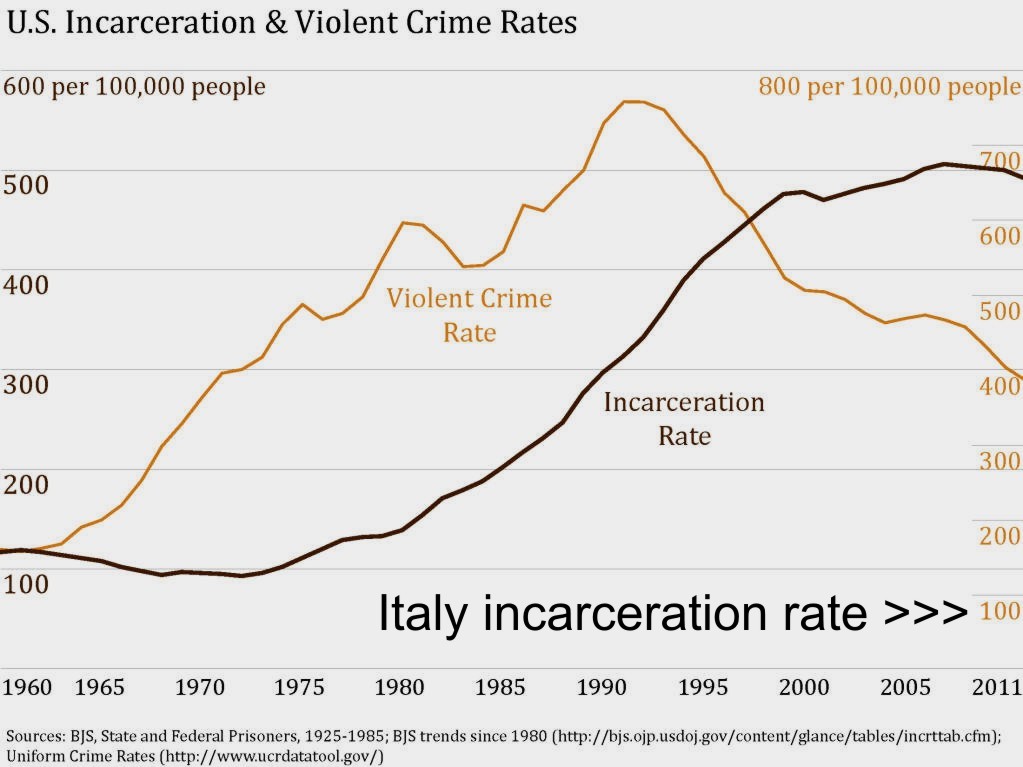
Italy is following closely the sad disarray currently obvious in the American system
Read our numerous posts setting right for example the false claims of Michael Heavey and Steve Moore. And then read this post and this post and this post and these new stories on US justice. And then answer the question below.
Michael Schwanke: Koch behind push to overhaul criminal justice system
Each year it’s estimated the United States spends almost a $100 billion on prisons. According to Mark Holden, Senior VP at Koch Industries, that’s three to four times what the country spends on education.
Holden and Charles Koch authored a letter titled “The Overcriminalization of America” and now are behind a nationwide push to overhaul the criminal justice system.
The letter points to the many federal laws created over the years. “Congress creates, on average, more than 50 new criminal laws each year. Over time, this has translated into more than 4,500 federal criminal laws spread across 27,000 pages of the United States federal code.”
“We all agree that our system isn’t working. Whether you’re a conservative, evangelical, social liberal, progressive, or libertarian there’s something for you. I don’t think there will be a lot of negative reaction to it,” says Holden speaking to Eyewitness News after addressing the downtown Rotary.
Holden says the U.S. accounts for about five percent of the world’s population, but holds 20 percent of the prison population. Most are non-violent offenders. Holden says one in three people in the U.S. has a criminal record which leads to poverty and joblessness.
Cara Tabachnick: Poll: Young Americans have “little confidence” in justice system
Nearly half of American young adults lack confidence in the nation’s justice system or don’t trust their local police to do the right thing, though that perception is deeply divided by race, according to a national poll of 18- to 29-year-olds released by Harvard’s Institute of Politics at the John F. Kennedy School of Government.
African-American youth had the deepest distrust of the nation’s criminal justice institutions, with 79 percent of those polled expressing little to no trust in their local police department to do the “right” thing.
Hispanic youth weren’t far behind, with 62 percent of those polled expressing little or no trust in their local police force. In stark contrast, just 31 percent of the white youth polled expressed little or no trust.
More than 3,000 people were polled by the Harvard Institute of Politics between March 18-April 1, on questions of criminal justice and other issues, including politics, climate change and terrorism.
Over all, there was an even split on the U.S. judicial system’s ability to “fairly judge people without bias for race and ethnicity.” About 49 percent of those polled said they have little to no confidence that the justice system can operate without bias.
Jason Fyk: Baltimore’s Criminal Justice System Is Corrupt, I Know Because I Was Imprisoned there
n 2011, I was arrested by Baltimore City Police on charges of conspiracy to commit first degree attempted murder.
You might be asking yourself, “Why? What did he do?” I took a cell phone video of a small drunken scuffle in a downtown Baltimore parking garage. I was not a participant in the fight, nor was I an instigator. Despite what the facts of the situation presented, a personal family relationship with one of the so-called “victims” took precedence over the law. What started as a typical two-sided misdemeanor became a one-sided fight for freedom. I spent 50 days in the Baltimore City Detention Center facing two life sentences, and a host of other charges mounting to well over 200 years in prison, all for simply taking a video.
I’ve seen the corruption firsthand. I’ve seen how a law enforcement agent’s personal agenda can destroy a life. I’ve seen how charges are ramped up in order to make a lesser charge stick. I’ve seen detainees entering jail with worse injuries than the participants in the fight I captured on video, all at the hands of police. I’ve also seen the corruption that resides in BCDC on my 50-day tour of the jail.
The conditions at this facility were sub-human, in some cases. Ignoring the mice, cockroaches and decaying conditions, basic necessities of life were severely lacking. The food was nearly inedible and, in some cases, hazardous. For example, the drink flavoring had a poisonous emblem on it, eggs were often brown and rotten when served, and during my stay we even lost water for four days, which meant toilets and sinks did not work. All we had was a cooler jug that was brought in to drink from. Showers were so hot (not adjustable) you could not stand in the water. I saw a detainee drop on the floor, having a seizure from withdrawal, because drugs are not administered for close to a week after arrival. My experience in jail was that of an educated observant, and what I saw was appalling. The list goes on and on.
So Italy or the USA - which country would you pick to do a crime in? Do Heavey or Moore tell you this? How many times have Heavey and Moore found justice lacking in the US? Apparently no times at all. One-note bashing of Italian justice is all that they do.
Did The State Department Offer Assurances To Knox She Never Would Be Extradited?
Posted by Ergon

US Sec of State Kerry (discussing Snowden) really needs extraditions to work
1. Overview
This is the first of two posts on the real source of an increasing flow of anonymous but seemingly official State Department claims that Knox’s extradition is not in the cards
2. The Current Italy/US Extradition Treaty
As repeatedly explained here by posting lawyers the Italy/US treaty is deliberately written to exclude any politics.
If either nation has arrived at a guilty verdict of someone currently in the other nation by following its own laws, then the other nation deliberately has no legal option but to extradite them to serve their term.
So far neither nation has ever refused to do what the treaty says and so far politics has never intervened. That helps both nations in pursuing other extradition cases around the world.
3. Claims By An Anonymous Source
“Will Amanda Knox Be Dragged Back to Italy in Murder Case?” This was by Nina Burleigh in a cover story in Newsweek on March 19, 2015 quoting an anonymous source.
A State Department source tells Newsweek that diplomats in both Italy and the U.S. expect an extradition request to be denied: “I don’t think either Italy or the U.S. wants a major burr under our saddle in terms of relationships between our countries, and this would be that, if the Italians pushed it.” If they do, the source adds, there “is not any way” the U.S. will arrest Knox, nor will it have her declared a fugitive.
The elected Italian government in Rome is separate from the judiciary, and traditionally the two branches do not have warm relations. “I know the Italian government was rolling its eyes” over the prospect of the case reaching this phase, the State Department source says, adding that Rome faces “a real political problem” if the judiciary requests extradition. The American diplomat predicts the Italian court won’t ask to extradite.
It seems that ever since Amanda Knox was wrongfully acquitted by the Hellmann appeals court of Perugia in 2011 we have been inundated with unsourced reports that “the United States would never extradite Amanda Knox.
Going back several years to the Daily Mail, Guardian, The Express and various American media, they all seemed to be reading from the same script:
- She hadn’t received a fair trial.
- American public opinion would “˜never allow her to be sent back”.
- The Secretary of State would quietly prevail upon his counterpart in Italy to not request extradition.
And, as the final appeal of Amanda Knox and Raffaele Sollecito came up to the last stretch it seemed that these same hacks were repeating the same talking points, even though much has changed since 2011.
These were the basic points, reported over and over in the main stream media till it almost seemed like a guarantee. So I have been looking for the last three years to verify the truth of that. And, who made that promise, if any were made? These were the basic parameters of my search, and I had to tune out the background noise of “˜double jeopardy” and “˜dueling extradition experts”.
Then I had to look for the “˜unnamed source” quoted in all the news reports.
These possibilities came up:
- WA US Senator Maria Cantwell spoke to her colleague Sen. John Kerry of the Senate Foreign Relations Committee who spoke to his brother in law David Thorne, the former US Ambassador to Rome, who passed on a quiet message to the Italian Foreign minister. But would they ever speak on or off the record to reporters or like it very much if it was going to be bruited about?
- Mid-level Friends Of Amanda Knox like Anne Bremner and Judge Heavey had received vague assurances from Senator Cantwell; somehow extrapolated as iron clad guarantee that Knox would never be extradited, never mind there has not been any precedent I can find that would apply to a similar case like this.
- Someone in the Department of Justice and/ or State is feeding them shite.
- The FOA are making it all up. That last was my favourite, given that they are led around by people like Steve Moore, Bruce Fischer, and J. Michael Scadron.
4. My Search For The Truth
This has been an interesting journey, and as always, things seem to just come together at the last moment. It has helped that I have been watching diplomatic activity up-close all my life.
My father was in the Pakistani Foreign Service stationed in London, so, shortly after I was born, lived in the UK from age 0-3, then with the Pakistan Embassy in Tokyo from age 3-8. We were a cosmopolitan group of embassy brats going to St. Mary’s International School.
My friends were American, Iranian, Turk, Indian, East German, Canadian, New Zealand, points all over. Their parents were all diplomats and I made lifelong friends. My father could have received a posting as assistant to the ambassador to Washington D.C. after that but fate prevailed as he’d been stationed out 8 years and had to be rotated back to Pakistan.
Since that time I kept in touch with my friends and also developed this passion for International Relations and Geopolitics. Traveling to the US and other countries but also meeting over the internet, made many more friends at various levels of the State Department. Saw the changes there as respected career diplomats got replaced by interest groups and major donors to political parties. Such only went to choice postings, of course, but not second or third world countries, so I had many interesting discussions with them over the years.
The Wikileaks cables were a revelation as Embassy intercepts showed the thousand different ways diplomacy led to but also tried to prevent, war. I’d been reading them ever since they first came out so started searching for links to secret discussions with Amb. Thorne. Couldn’t find anything except what already was reported, so reporter Andrea Vogt’s FOI request find was a goldmine:
NEWLY RELEASED EMBASSY CABLES SHED LIGHT ON STATE DEPT HANDLING OF AMANDA KNOX CASE
By Andrea Vogt
FEBRUARY 13 “Newly released state department documents show the U.S. Embassy in Rome declared the Amanda Knox matter “Case Closed” in a cable to Washington just days after the American’s clamorous 2011 acquittal. The memo reveals wishful thinking on the part of some U.S. diplomats, who were only too eager to see the thorny case come to a clean close.”
In Update March 23, 2015 posted today, Andrea Vogt says this:
In a 2011 Italian embassy cable released as part of several Freedom of Information Act requests I’ve filed on this case (first published Oct 11, 2011) [US] diplomats in Italy mistakenly thought Knox’s acquittal in 2011 would bring to a close this complex and divisive international case. Italy’s Court of Cassation would prove them wrong, overturning her Perugia acquittal and ordering a second appeal in a different venue (Florence) which ended last year with a guilty verdict.
So is a political fix being attempted or already in? See my Part Two Conclusion to be posted next.
The Unsavory Company Knox Would Be Foolish To Aspire To: 160 Americans On The Run From Interpol
Posted by Peter Quennell

Meet eight American women on the run from arrest worldwide.
They are all the subjects of Interpol Red Notices. Right now Interpol has 322 active Red Notices, some 160 of them for Americans, of which 51 are women.
If they have not yet been to trial, they are considered innocent unless and until they are proven guilty. At the same time many have cash rewards on their heads and private citizens are warned not to apprehend them.
None of those eight women above are charged with murder or already found guilty of murder - their alleged crimes include kidnapping, drug-smuggling, fraud and insider trading.
Red Notices are sometimes issued for killers, but they very rarely prove necessary. Regardless of the status of mutual extradition treaties, countries who find they are harboring killers tend to regard them as hot potatoes, and most usually simply arrest them.
Some on the list of 322 may be dead, and many will be living close to poverty. We posted here previously on Interpol and here previously on how the ex CIA chief in Italy Robert Lady was forced out of Panama by an impending arrest for a Red Notice.
Robert Lady has lost everything. Seems better to face the music, and end the doubletalk.
The Dangers Of Not Extraditing Convicted Felons Labeled An Explosive Threat To Other People
Posted by Peter Quennell

Above: Sydney moslems leaving wreaths- for the non-moslems killed
1. Lessons From Australia
It looks like several Australian judges may have wrecked their careers for allowing Man Haron Monis to be at large even though police said he should be denied bail.
Man Haron Monis was the former Iranian who took 17 hostages in downtown Sydney and caused the death of two others and himself. Coming to light is how many times previously the Australian justice system had treated him with kid gloves for major crimes.
Iran tried to extradite the gunman behind Sydney’s deadly hostage crisis years ago, Tehran’s top cop said, amid questions over how the self-styled cleric had found his way to Australia but not onto a watch list…
Monis grew up in Iran as Mohammad Hassan Manteghi. In 1996, he established a travel agency, but took his clients’ money and fled, Iran’s police chief, Gen. Ismail Ahmadi Moghaddam, told the country’s official IRNA news agency Tuesday.
Australia accepted him as a refugee around that time. The police chief said Iran tried to have Monis extradited from Australia in 2000, but that it didn’t happen because Iran and Australia don’t have an extradition agreement.
Australia’s Prime Minister Tony Abbott said he wanted to know how Monis had been granted permanent residency and why he had been receiving welfare benefits for years, despite being able-bodied “if not necessarily of sound mind.”
Monis had a gun licence, a rarity in Australia - and he walked free after being charged for writing letters of hate to families of dead Australian soldiers, and for having a hand in the killing of his wife.
2. The Relevance Of This To Knox
Regardless of extradition treaty situations, countries almost universally extradite convicted murderers. They dont want dangerous people to have another chance to cause deadly havoc in their own midst.
Knox is already a felon for life. If Knox is confirmed guilty of murder next March she will be a DANGEROUS felon for life.
The Italian-US extradition treaty gives a US judge no wiggle room other than to check if the paperwork is in order and then send her on her way.
But another bent judge could again throw a spanner in the works.
How dangerous is Knox? Our psychologists generally think that, untreated, she is not good news. Not a latent serial killer, or one who sits around and plots, but one who could again explosively hit back when she imagines or exaggerates slights.
More than anyone in Perugia, Meredith tried to get along with Knox. But Knox showed no sign of a learning curve. The very heavy drug use went on, the sleeping with a drug dealer went on, the dirtiness and laziness around the house went on, and the noisy sex episodes with strangers through paper-thin walls went on.
She really was the housemate from hell.
For a month or two after Meredith died, Knox was highly erratic about her role in that death, and showed an extreme eagerness to talk with the prosecution which resulted in the long session with Dr Mignini on 17 Dec.
In a move serially misinterpreted by the dimwits of the Knox brigade, the prosecution, suspecting she was both mixed up and high on hard drugs, in effect offered Knox and her team a way to a lesser count, when they said that the murder could have been a taunting attack which spun out of control.
In her book, Knox describes how the family and lawyers worked hard on Knox to destroy all elements of trust. By the summer of 2008 she was in a mood of full-blown paranoid mistrust, and all chances of a lesser charge were gone.
At trial in 2009 Knox was daffy and uncomprehending, making irrelevant interventions and really shooting herself in the foot when she took the stand. Raffaele Sollecito and Patrick Lumumba, almost the last two in Perugia to still give her the time of day, both said she was very odd.
Knox was mentally tested in Capanne Prison and apparently scored high on the psychopathic chart. The four courts hardest on Knox all knew this - the Matteini court, the Ricciarelli court, Cassation, and the Nencini court - which was a major reason why Cassation did not allow bail in April 2008.
Assuming she killed once, in what was an exceptionally barbaric attack, Knox may or may not kill again. She is certainly inciting or condoning a massive amount of dangerous hate toward Meredith’s family and toward the Italian officials of the court.
One unhinged attack has already occured - that of the disturbed Michele Moore against Dr Mignini in the Perugia court - and the British resident David Anderson has screamed at meetings and runs an incessant campaign to stir up hate. Court officials have received messages of hate, and there is a small mountain of false and dangerous accusations against them on the web.
Left untreated and unpunished, a convicted but not extradited Knox would be a killer walking loose on American streets and could continue to condone or incite violence for the rest of her life.
If Knox killed and remains loose, could she kill again or cause others to kill? Any extradition judge needs to ask as the Australian judges did not:
Do we REALLY want to find out?
Why Numerous American JUDGES Favor The Supremely Neutral Italian Kind Of System
Posted by Peter Quennell
See that above at the bottom of the YouTube screen? Some $280 million has been spent since the year 2000.
Can you guess what the $280 million was for?
In fact the $280 million is funds raised and spent for judges’ election campaigns in the roughly 3/4 of all American states where such judges’ elections are held - the original intention of which was good: to get judicial choices out of smoke-filled rooms.
Sitting judges and prospective judges themselves usually dont like this fundraising, because they have to take time off to raise these funds, and pressures from donors - including bad-boy donors and in some cases defense lawyers seeking a break - can become extreme.
We have posted previously on enlightened American lawyers favoring main aspects of the Italian kind of system and on American cities now doing the same. Now we see many American judges and public-interest groups inclining the same way.
Why all judges in Italy are impartial and well-trained in the extreme (like all prosecutors) and dont have to keep their paws outstretched is that they are in a merit-based system where only their performance and not their politics counts.
We described how Italian justice system officials have to jump hurdle after hurdle in getting their cases advanced. A very demanding process in which only the best succeed.
It’s the same with their careers. They have to jump hurdle after hurdle in exams and peer assessment to advance from level to level - to make it as high for example as this revered prosecutor here.
Do such serial defamers of the Italian system as Doug Preston and Steve Moore and ex-judge Michael Heavey bother to tell you this about the Italian system? Probably not. They have never been truthful about it before.
The US Lacks Legal Authority To Decline To Deliver A Guilty Knox To Italian Authorities
Posted by TomM

[Rome airport; exceedingly rare for those convicted of Italian crimes not to be sent back via here]
The reporting on this case has, with few exceptions, been poor.
Recent reporting on whether the US would extradite Amanda Knox continues that tradition, ranging from assertions that “sources” within the State Department say they would never extradite her, to claims that the risk of extradition is real, but that the Secretary of State has the discretion to refuse to extradite.
If the Secretary of State actually has this discretion, it must be grounded in the law.
That means it must be found in the Constitution, or in an act of Congress, or in a treaty—all of which constitute the “law of the land”. Beyond authorizing the President to make treaties, with the consent of two thirds of the Senate, the Constitution sheds no further light.
The only act of Congress dealing with extradition of US citizens is Title 18, United States Code, section 3196; a bit of background first.
There is no uniform US extradition treaty. Each treaty is separately negotiated with the other sovereign nation. Historically, many of the treaties entered into by the US contained clauses providing that neither country was obligated to extradite its own citizens.
Notwithstanding this, the US had extradited US nationals on the basis of discretion to extradite even though extradition was not required by the language of the treaty. But in 1936 the US Supreme Court held that if the treaty does not “obligate” the requested party to extradite its own citizens, the Secretary of State does not have the discretion to deliver the person sought to the requesting country. [Valentine v. United States ex rel. Neidecker 299 U.S. 8]
In 1990, Congress passed 18 U.S.C § 3196, captioned “Extradition of United States citizens:”
“If the applicable treaty or convention does not obligate the United States to extradite its citizens to a foreign country, the Secretary of State may, nevertheless, order the surrender to that country of a United States citizen whose extradition has been requested by that country if the other requirements of that treaty or convention are met.”
That is the full extent of Congressional action on extradition of US citizens; there is no Congressional grant of discretion to the Secretary of State to decline extradition in the face of a treaty obligation.
Some US extradition treaties contain clauses that give the requested country the discretion not to extradite its own citizens; perhaps that is where the idea that the Secretary of State has discretion not to extradite Knox comes from.
Here, for example, is a clause from the US-Sweden treaty:
“There is no obligation upon the requested State to grant extradition of a person who is a national of the requested State, but the executive authority of the requested State shall, subject to the appropriate laws of that State, have the power to surrender a national of that State if, in its discretion, it be deemed proper to do so.”
The treaty with Italy is short (ten pages) and written in plain language. The treaty has commences with Article I, captioned “Obligation to Extradite”:
“The Contracting Parties agree to extradite to each other, pursuant to the provisions of this Treaty, persons whom the authorities of the Requesting Party have charged with or found guilty of an extraditable offense.”
The cover letter of the Secretary of State to then-President Reagan explains: “Article I obligates each State to extradite to the other, in accordance with the terms of the Treaty, any persons charged with or convicted”¦”. (emphasis added)
There are mandatory grounds for refusal, such as political or military acts, double jeopardy (if the person sought has already been tried by the requested State for the same offense), or if the prosecution or penalty is time-barred in the requesting State.
There is just one discretionary ground: if the country requested is also prosecuting the person sought for the same act.
Article 4 provides:
“A Requested Party shall not decline to extradite a person because such a person is a national of the Requested Party.”
Thus, any discretion to deny extradition implied by 18 USC 3196 has no application to requests made under this treaty. Further, although some appellate cases have treated some issues regarding extradition of nationals differently, they fairly firmly hold to the difference in the meaning of mandatory words like “shall” and “obligate” on the one hand, and discretionary or permissive words like “may”.
Comments to the effect that the US has declined extradition to Italy in the past are superficial and uninformed.
The first illustration such commentators cite is that of the Air Force pilot who severed a ski lift cable, causing multiple deaths. That was not an extraditable offense under the treaty because of double jeopardy; the pilot had been court martialed. Although his acquittal enraged Italians, the pilot had already been tried by the US, and thus his case fell under the mandatory ground to denial of extradition specified in the treaty.
The other example mentioned is that of the CIA operatives who were prosecuted in absentia for the abduction of Abu Omar in Milan. The Italian Minister of Justice refused, during both the Berlusconi and Prodi administrations, requests of the Milan court to commence extradition proceedings. In Italy, the courts and the government are independent, and the courts lack power to compel government to make a request for extradition.
Even if the Italian government had made an extradition request, there is at least a colorable argument to be made that this was in the nature of a military act in the US war on terror, thus constituting a mandatory ground of refusal.
Thus, if Italy requests the extradition of Amanda Knox, the US lacks legal authority to decline to deliver her to Italian authorities. If the US government wants to avoid extraditing her, it will have to rely on diplomacy rather than law. In other words, it will need to convince the Italian government not to make an extradition request in the first place.
How Many Extraditions Do The US And Italy Refuse? Approximately Zero, When It’s To Each Other
Posted by Peter Quennell
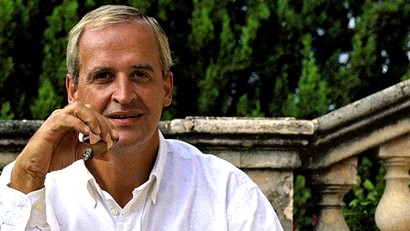
[Ex-fugitive Florian Homm above and below in front of his palatial Mallorca Spain home]
The State Department and FBI collaborate more closely with their Italian counterparts than with almost any others in the world.
Italy is a very loyal political ally to the US and has helped out a lot diplomatically and militarily around the world. The FBI and their Italian counterparts in Rome have officers permanently embedded from one another and there are dozens of transactions going on all the time..
Extraditions both ways take place without fuss at the rate of a few a year, which the State Department and Justice Department are not inclined to fight. A couple of weeks ago, the Supreme Court in Rome declined the final appeal of fugitive swindler Florian Homm and sent him on his way to the US.
Homm had many millions to pay top lawyers to fight his extradition case. But he still lost.
The only extradition requests from Italy the US doesnt fulfill are the CIA kidnaping in Milan and Air Force Dolomites case.
It is the CIA and Pentagon overtly or clandestinely exercising special military privileges that is the cause of the two standoffs. NOT the Department of State, which has made clear it is not too thrilled.
Contrary to broad confusion in the US (fed by biased stories from Colleen Barry of the Associated Press) the Florence appeal is not a second or third trial of Knox.
It is a FIRST appeal, actually filed by Sollecito and Knox, on the same lines as any American first appeal, after the previous Hellmann appeal was furtively bent, and then scathingly annulled. Knox has been in provisionally guilty status since late in 2009.
So double jeopardy absolutely does not apply.
The one REAL difference between this appeal and any American appeal, which seems over Colleen Barry’s head, is that this appeal request was automatically allowed. Any American appeal judge (except Heavey, who serially gets the hard facts wrong) would have thrown the flimsy appeal grounds out.
It may take up to a year, if Amanda Knox chooses to waste more big bucks on lawyer fees - their batting record for that is pretty dismal so far, though, and a confirmed-guilty verdict in Florence next week might be only the start of more legal strife. False claims in her book will soon see her back in court.
But it seems 100% likely that Italy will “get their man”. To a rapidly increasing number of Americans, Italy’s gain would also be the US’s gain.
The Considerable Number Of Suspected Perps That Countries Extradite Daily To Other Countries #2
Posted by Peter Quennell

[Interpol HQ is now in Central France, a new HQ is planned for outside Paris soon.
Extradition: a hardball game.
This is the latest of many posts which include this legal take explaining the gloomy prospects for Sollecito and Knox if their final conviction comes down.
Complete refusals of extradition by any countries other than Russia and China seem increasingly rare, as that can cause a rebound effect and economic retaliation in response. The United States very rarely refuses to extradite.
If anything, the US is stepping up the pace of its extradition cases - both ways. The US at federal and state level is at any one time processing hundreds of requests, and transporting suspected perps back and forth.
These are some of the high-profile extradition cases in today’s news:
The US/Italy Robert Lady case
The twists and turns in the story of the fugitive from Italian justice and former CIA chief in Milan Robert Lady were last posted on here. He scampered out of Central America back to the United States mid-2013.
But now official Washington seems to be giving Mr Lady a very hard time which may have him voluntarily headed to Italy to seek a break.
When the anniversary of 9/11 came around this year, Robert Seldon Lady was moving between low-end hotels around Miami. An international arrest warrant keeps him from returning to his home in Panama. He says he’s flirting with personal bankruptcy, fears for his life, and is “getting pretty desperate.” His marriage is broken. He blames this hard luck on his former employer, the Central Intelligence Agency
Mr. Lady helped CIA contractors and agents snatch an Egyptian Islamist off the streets of Milan and deliver him to an interrogation cell in Cairo. This so-called extraordinary rendition””one of 130 or so carried out by the Bush administration””set in train events that soured America’s relations with Italy and upended the life and career of Mr. Lady and other CIA agents.
Saying “I’m fed up with all this,” Mr. Lady has some extraordinary steps in mind to change his fate. His actions and outspokenness are going to add to the discomfiture of his former bosses at Langley over this messy episode from the early days after 9/11.
If the muddle-headed Knox and Sollecito enablers can find any solace in that, good luck. Mr Lady was a top government employee, who claims he was doing only what he was told.
The Brazil/Italy Henrique Pizzolato case
Believe it or not the former director of the Bank of Brazil has fled to Italy to ensure a fair trial.
Sentenced to 12 years and seven months in prison for bribery, embezzlement and money laundering, Pizzolato announced in a letter that he fled to have, according to him, a new trial in Italy “removed from politics and electoral motives” and in “a court not subject to the impositions of the media”.
Brazil might ask Interpol for a “red notice” which is the highest form of international arrest warrant and often has the same wanted result as formal extradition.
A red notice chills renegades’ possibilities worldwide.
In fact so tough is life on the lam under a red notice that perps often simply cave before too long, and head back to defend themselves or pay their dues without any court moves or official transport required.
The US/Italy Raoul Weil case
Finfacts reported on this case last month.
Raoul Weil, a former UBS wealth management chief, was arrested last weekend in Italy and faces extradition to the United States to answer charges of aiding and abetting tax evaders.
Weil left Switzerland’s biggest bank in 2009 after he was declared a fugitive from US justice by ignoring a criminal indictment issued in 2008. UBS was forced to pay a $780m fine in 2009 after admitting to actively assisting US tax evaders to break US law.
Several Swiss bankers and lawyers have since been indicted in the US for their alleged role in helping wealthy US citizens hide their assets from the tax authorities.
Weil is one of the most high-profile of the accused as a then head of UBS’s wealth management and he is now a temporary resident of an Italian prison, likely fearing a longer spell in a US one.
A Florida court indictment charged Weil with having a prominent role in aiding UBS’s US clients to hide around $20bn in undeclared assets between 2002 and 2007.
He however has strongly denied the allegation but would not risk defending himself in a US court.
Italy is giving Mr Weil a pretty hard time and accedes to all American extradition requests except where the death sentence might be involved.
The US/Russia gangsters case
The US is trying hard to get some Russian gangsters (okay, alleged gangsters) extradited from countries around the world and Russia is resisting this “extraterritorial application of America law”.
U.S. organized crime experts say Russian criminals working overseas often have connections within the Russian government, and that the Russian government’s defense of them is designed to keep those links from emerging in public light….
In the past six months, Russians have been a frequent target of arrest warrants executed at the request of U.S. prosecutors.
On Aug. 1, the Dominican Republic extradited 24-year-old Aleksandr Panin to stand trial in federal court in Atlanta on charges related to cyberscams using SpyEye malware, which enables the theft of online banking information. Panin is accused of stealing $5 million from U.S. banks.
In mid-August, Lithuania extradited an alleged arms dealer, Dmitry Ustinov, to stand trial in the United States for allegedly negotiating to sell restricted night-vision goggles. He faces a 20-year sentence.
Another Russian, Dmitry Belorossov, was arrested at the Barcelona airport Aug. 17 upon triggering an Interpol fraud alert. Belorossov’s extradition to stand trial in the United States is pending.
When U.S. prosecutors seized Liberty Reserve in late May, they said the company had laundered “more than $6 billion in criminal proceeds.” Liberty Reserve allowed clients anonymity and offered them a digital currency, known as an LR, to facilitate payments for criminal activity.
The US/Spain Javier Martin-Artajo case
Banker Javier Martin-Artajo now in Spain is refusing to be extradited to the United states - because the crime he is accused of took place in England. Good luck with that one. JP Morgan Chase Bank has just paid a huge fine in the US so THEY accept the crime took place there.
The Prospects In Favor Of A Possible Fugitive Amanda Knox Take Yet Another Hit
Posted by Peter Quennell

[Above and at bottom: Panama, where the fugitive Robert Lady was setting himself up to be untouchable]
The former CIA operative Robert Seldon Lady is on the lam from Italian law.
He is now a worldwide fugitive - with fewer governments stepping forward with offers for him than for the other famous fugitive Edward Snowden. We posted briefly on the case here and here and two weeks ago Barbie Nadeau posted a good update here.
Robert Lady was the leader of the team that kidnapped the supposed Egyptian radical Abu Omar in Milan in 2003. Then he escorted Abu Omar to Egypt and he was apparently present for some months while Abu Omar was tortured.
The Milan court put online in English this 210-page summary of the case against Robert Lady and another 18 Americans who were involved. Amazing reading. What absolute buffoons. In total 25 Americans and 9 Italians were accused, though not all were put on trial, and as Barbie Nadeau explains, all of the others received Italian leniency.
Robert Lady didnt, though, and after he was convicted in absentia in Milan he took off out of the United States for central America. The CIA might have continued to help him there, though there were signs that the State Department and Rome Embassy, who have many other important dealings with Italy, were pretty ticked.
One CIA operative even sued State for diplomatic immunity (none of them were granted it).
When it became known that Robert Lady was living in Panama (a country without an extradition treaty with Italy) and close to citizenship, Italy through Interpol issued a worldwide arrest warrant, and requested that Panama round him up.
A few days ago, Robert Lady sought to move to the next country, Costa Rica, and was briefly detained.
What happened next is very murky. But it seems that Robert Lady was headed for the US by air, with possible help from some arm of the federal government - and then he just suddenly disappeared.
Last week, the Panamanians picked him up. It was the real world equivalent of a magician’s trick. He was nowhere, then suddenly in custody and in the news, and then””poof again!””he wasn’t. Just 24 hours after the retired CIA official found himself under lock and key, he was flown out of Panama, evidently under the protection of Washington, and in mid-air, heading back to the United States, vanished a second time.
State Department spokesperson Marie Harf told reporters on July 19th, “It’s my understanding that he is in fact either en route or back in the United States.” So there he was, possibly in mid-air heading for the homeland and, as far as we know, as far as reporting goes, nothing more. Consider it the CIA version of a miracle. Instead of landing, he just evaporated….
Having vanished in mid-air, he has managed so far not to reappear anywhere in the US press. What followed was no further news, editorial silence, and utter indifference to an act of protection that might otherwise have seemed to define illegality on an international level.
There was no talk in the media, in Congress, or anywhere else about the US handing over a convicted criminal to Italy, just about how the Russians must return a man [Snowden] Washington considers a criminal to justice.
Nevertheless, a thorn in the flesh of American-Italian relations has been disappeared, suggesting that the pro-friends-with-Italy State Department line is dominant. Having lost everything , the former US officlal Robert Lady is now a world-wide fugitive and further US help if any is likely to be very furtive.
Confessed druggie and convicted felon Amanda Knox, a private citizen, can hardly expect any more official deference.
Italy’s Advanced, Effective, Humane Law & Order System Also Adopted By City Of New York
Posted by Peter Quennell
The main characteristics of the Italian system are (1) a large and visible national and local police presence, (2) a low crime rate even by European standards, and even more-so by American standards, and (3) a very low rate of incarceration that is only 1/6 that of the US.
Pretty well the exact opposite of what you’d suppose if you read only Frank Sforza and Raffaele Sollecito and Bruce Fischer and Saul Kassin and Steve Moore and of course Mario Spezi. Read only them, and one might be excused for thinking Italy’s is a huge, horrible system the Italian population desperately needs them to save it from.
Get a life!
An extremely misconceived campaign if the real purpose (we do wonder) is to do anything helpful for in particular Amanda Knox. The average Italian in the street likes and respects and is proud of their system. Polls repeatedly show that the institutions of that system are the most trusted and respected in Italy.
The general mood is probably toward a bit less concern about all perps and a lot more concern about all victims. But essentially the system is liked for what it is. Conspiracy theories don’t fly.
New York is now the safest big city in America. It is following a route that is not only almost identical to Italy’s - it is being watched and emulated elsewhere across the US. All of John Tierney’s important report in last Friday’s New York Times is worth a read, for this could represent a huge sea-change.
These are the openings paras.
Now that the United States has the world’s highest reported rate of incarceration, many criminologists are contemplating another strategy. What if America reverted to the penal policies of the 1980s? What if the prison population shrank drastically? What if money now spent guarding cellblocks was instead used for policing the streets?
In short, what would happen if the rest of the country followed New York City’s example?
As the American prison population has doubled in the past two decades, the city has been a remarkable exception to the trend: the number of its residents in prison has shrunk. Its incarceration rate, once high by national standards, has plunged well below the United States average and has hit another new low, as Mayor Michael R. Bloomberg announced recently. And crime in the city has fallen by more than 75 percent, almost twice as much as in the rest of the country.
Whatever has made New York the safest big city in America, that feat has certainly not been accomplished by locking up more criminals.
“The precise causes of New York’s crime decline will be debated by social scientists until the Sun hits the Earth,” said Michael Jacobson, a criminologist who ran the city’s Correction and Probation Departments during the 1990s and is now the president of the Vera Institute of Justice, a criminal justice research group. “But the 50,000-foot story from New York is that you can drive down crime while decreasing your jail and prison population “” and save a huge amount of money in the process.”
New York’s singular success has attracted attention across the country from public officials whose budgets have been strained by the prison boom. The 2.3 million people behind bars in America, a fifth of the world’s prisoners, cost taxpayers more than $75 billion a year. The strict penal policies were intended to reduce crime, but they have led to a historic, if largely unrecognized, shift in priorities away from policing.
“The United States today is the only country I know of that spends more on prisons than police,” said Lawrence W. Sherman, an American criminologist on the faculties of the University of Maryland and Cambridge University in Britain. “In England and Wales, the spending on police is twice as high as on corrections. In Australia it’s more than three times higher. In Japan it’s seven times higher. Only in the United States is it lower, and only in our recent history.”
CIA v. State Department: A Significant Development For The Perugia Case?
Posted by Peter Quennell

As expected the Supreme Court of Cassation has upheld kidnapping convictions against 23 CIA operatives.
The landmark case dates to Feb. 17, 2003, when Hassan Mustafa Osama Nasr, a radical Egyptian cleric known as Abu Omar [image below}, walked out of his Milan apartment in broad daylight and vanished.
talian authorities used cellphone records made at the time and location of the abduction to determine that CIA officers snatched Abu Omar, drove him to nearby Aviano Air Base and flew him to Egypt. According to Italian court documents,
Abu Omar was beaten and subjected to electric shock in a Cairo prison. He was later freed.
The significant development for Meredith’s case is that the State Department had refused to organize diplomatic immunity with Italy for any of the 23.
Now at least one of them, Sabrina De Sousa (image at top with her lawyer), is suing the State Department for not having stood by her in retroactively organizing that diplomatic immunity.
All 23 could now be the subject of requests for extradition to Italy to serve out their six-year sentences, and if the US Justice Department refuses to comply they could be the subjects of worldwide arrest warrants via Interpol.
That could mean the end of their operational usefulness in the CIA and conceivably prevent any of them ever traveling outside the US again in their lifetimes.
Why have the CIA and the State Department seriously parted company here? Well, their mandates are almost polar opposites.
The State Department and its Embassies and the very considerable American presence throughout the United Nations tries hard to get along with friendly nations, and Italy is probably one of its top half-dozen friends.
The CIA on the other hand is charged with using fair means and foul to fight back against terrorism worldwide, and sometimes its practices contravene the best interests of diplomacy and the local law.
Here the CIA is coming out the clear loser and State is sweetly sitting on its hands and not upsetting Italy in any way.
Cables released so far by the State Department under the Freedom of Information Act suggest that State and the Rome Embassy really didnt ever lift a finger to subvert Italian justice on behalf of Amanda Knox.
Here’s betting more of the same - no action by State - as the Cassation appeal comes alive. And no standing in the way of an extradition request for Knox if Cassation decides Judge Masssei got the trial right.

Compared To Italy, Say, Precisely How Wicked Is The United States?
Posted by Peter Quennell
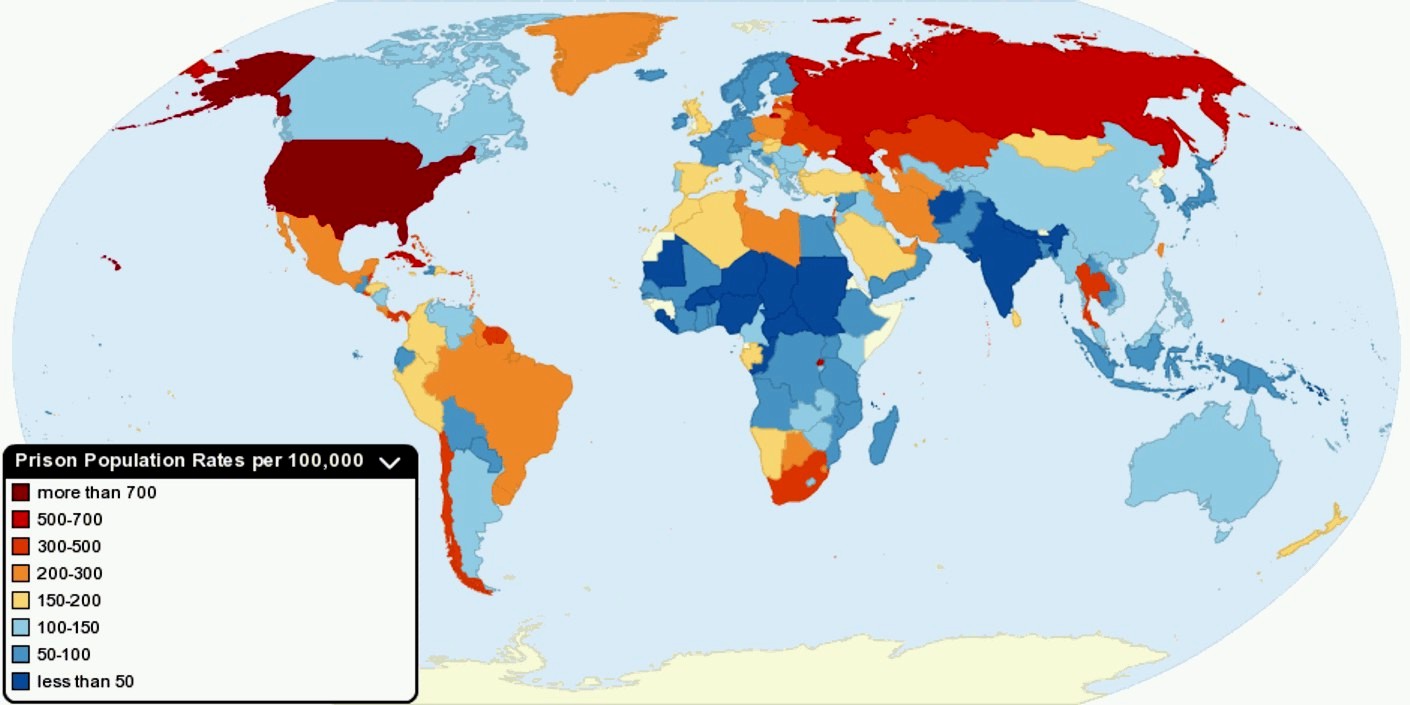
Please click above for a chart we can all read.
Okay. According to this proportional comparison of prison populations, the US is about seven times as wicked as Italy.
We have often remarked that Italy’s crime rate is low, the three mafia families (Sicily, Calabria and Naples) are mostly fading, and the justice system is one of the most cautious - conviction rates are infuriatingly low for the suffering families of victims, but in a forgiving Catholic nation rates of incarceration are unlikely to jump any time soon.
The American incarceration rate in sharp contrast has for a decade led the rest of the world, and it increased every year for nearly 30 straight years from the arrival of President Reagan to the departure of President GW Bush. Its prison rate is ahead of Russia’s, with its mafias and corruption and poverty, and ahead of China’s, with its large population of political prisoners.
Finally, however, the American incarceration rate and execution rate are both now headed downward.
Factors that had been keeping incarceration rates high included the 1980s-1990s drug wars, the estimated 12-15 million illegals, the estimated several hundred million private guns, the law-and-order hard line of many politicians and the Supreme Court, the elections of many sheriffs and judges and district attorneys based mainly on a law-and-order hard line, the part-privatised for-profit prison system, and distinct racism (see graphs below) in who goes to prison and who doesn’t.
Factors that are now pushing incarceration rates down include a major drop in all crime rates, the liberalization of US society as it gets richer, the pressure on government budgets, the easing of certain drug laws, the proofs from DNA that police do not always get the right perpetrator, Obama-administration investment in re-entry programs and more effective methods of parole and probation, and the continued push of humane people to radically change things for the better.
Executions were put on hold by the Supreme Court for some years. You can see from the last graph below that after that ended there was something of a surge in executions, but the numbers are sinking down again quite sharply (now at about 30 a year) and execution might be a thing of the past by 2020.
Wow! In matters of crime and punishment the United States is now starting to converge upon… Italy!
Jury Sequestration Coming Under Fire From Those Who Question The Casey Anthony Verdict
Posted by Peter Quennell

[Above and below: The jury’s Rosen Shingle Creek Hotel in Orlando; there are more images here].
The jury was imported for the Casey Anthony trial from a Gulf of Mexico town 100 miles west. They stayed in this hotel for nearly seven weeks.
Now they are rather defiantly starting to speak out (see the ABC News video posted below) to explain that, given big gaps in the evidence against Casey Anthony, and the dubious scenario presented (that she put the baby she loved to sleep with chloroform and duct tape in the trunk of her car while she went off to have a good time), they did what they had to do: unanimously vote no on the charges of murder and manslaughter.
There seem to be no signs that during the trial a hue-and-cry media had any pro-guilt effect on their thinking - in Tuesday’s post we suggested that if anything it seemed to do quite the opposite.
But it is now being suggested that while staying all together in this hotel the 20 jurors became just a little too chummy.
The former Los Angeles prosecutor Marcia Clark, who is critical of both the verdict and the prosecution, argues in the Daily Beast that jury members themselves are signaling that their sequestration was a very big factor.
I’m going to start by saying that, for those who thought the jury came back awfully fast””less than eleven hours spent in deliberation, you should now wonder what took them that long. Because from the very first vote, this jury was already close to a unanimous verdict of acquittal - at least as to murder: ten to two for not guilty. That’s an impressive show of solidarity for a first vote. And it shows they were almost unanimously inclined to acquit right from jump.
It’s the fact that this jury was already in sync in a case that posed so many debatable issues is what’s so noteworthy. And it has everything to do with sequestration. This jury was sequestered for more than two months. When jurors are forced to spend day and night with each other, apart from their families and friends, they become a tribe unto themselves. Because they only have each other for company, and because most people prefer harmony to discord, there’s a natural desire to cooperate, to compromise in order to reach agreement. And they have no safe retreat. If they disagree with their fellow jurors, they can’t go home to a husband, a wife, a friend, where they can regroup and marshal their energies. Make no mistake about it, sequestration is no picnic and I have sympathy and respect for the jurors who put up with that incredible hardship.
But we can’t ignore the mental and emotional impact it has on the jurors””an impact that likely thwarts the whole point of drafting twelve individuals to decide a defendant’s fate. The point of having twelve jurors is to have an array of differing points of view. The belief is that people of different backgrounds and experience will naturally bring a variety of attitudes to bear, and thus produce a more balanced view of the evidence. What one juror doesn’t get, another one does, and each of them sees different aspects to each witness and piece of evidence. The idea is for them to share differing views and reach a greater understanding””not to have them shave off their square corners so they can all roll together.
Unfortunately””and psychological studies bear this out””a group that is kept together for any length of time becomes more and more alike, more in sync, as time goes on. (By the way, this phenomenon is also in play with regard to proximity to the defendant. The longer the jury is in contact with the defendant, the less sinister he or she appears. In this way, familiarity with Casey Anthony turned her from a potential murderer to an abused, perhaps disturbed, but certainly nonthreatening, child.) Add this phenomenon to the natural desire to avoid contentiousness and seek harmony and you can see how individuality begins to erode in a sequestered jury.
Now add to that the psychology of group dynamics””a subject well known to trial lawyers and jury consultants. In every group there will be leaders and followers. Listening to Juror Jennifer Ford, who was very likely a leader, it became abundantly clear that the leaders on the Anthony jury were cheerleaders for the defense.
Interesting Tilts Of Marcia Clark And Alan Dershowitz Toward Educated, Informed Italian-type Juries
Posted by Peter Quennell
Neither of these heavy hitters are saying to abolish the common-law system of not placing professionals in the jury room.
Or for that matter to swing over to a semi-professional and seemingly less error-prone system like Italy’s, where the judges stake their own reputations on their verdict and the written explanation that must follow.
But both found the Casey Anthony non-guilty jury verdict a bit peculiar, and Alan Dershowitz specifically suggests that semi-professional jury systems (like Italy’s) tend to be more accurate.
Above, the former prosecutor Marcia Clark commenting a couple of weeks ago on why the media boosted the Casey Anthony trial into such a “fry her” phenomenon. And here in the Daily Beast she comments on why that media angle had no sway over the jury.
For one thing the evidence and scenario had some major gaps. And for another:
[American] jury instructions are so numerous and complex, it’s a wonder jurors ever wade through them. And so it should come as no surprise that they can sometimes get stuck along the way. The instruction on circumstantial evidence is confusing even to lawyers. And reasonable doubt? That’s the hardest, most elusive one of all. And I think it’s where even the most fair-minded jurors can get derailed.
How? By confusing reasonable doubt with a reason to doubt. Some believe that thinking was in play in the Simpson case. After the verdict was read in the Simpson case, as the jury was leaving, one of them, I was later told, said: “We think he probably did it. We just didn’t think they proved it beyond a reasonable doubt.” In every case, a defense attorney will do his or her best to give the jury a reason to doubt.
“Some other dude did it,” or “some other dude threatened him.” But those reasons don’t necessarily equate with a reasonable doubt. A reason does not equal reasonable. Sometimes, that distinction can get lost.
Former Harvard Law professor Alan Dershowitz went deeper into jury principles on the Piers Morgan interview show on CNN last night.
DERSHOWITZ: Well, if you want justice, don’t look to the criminal law system. That’s not its job. Its job is not to produce a just result. Its job is to produce a legally correct result.
We have a system that says better 10 guilty go free than one innocent be wrongly confined. If you have a 60 percent likelihood a person did it, you must acquit. If you think he probably did it, you must acquit. If you think he almost surely did it, you must acquit.
We acquit lots of guilty people, and that’s the right thing to do. When we convict an innocent person, that’s the wrong thing to do. That’s our system of justice. Many people don’t like it. Many people think the opposite, that we have too much popular justice, too much dependent on elected prosecutors, elected judges, elected officials.
The French, for example, don’t understand our stem with a case that’s going on now with the rape in New York. They don’t understand our system. They say it’s much too popular. In France, there’s a professional system. They have professional judges, professional prosecutors, professional jurors.
We’ve opted for a much more democratic system, and it means that in the end you’re going to be dissatisfied with a lot of verdicts. Just don’t expect too much from our legal system. Don’t expect truth. Don’t expect justice, because that’s not what it’s supposed to give you.
It’s supposed to give you a legal process that only convicts if admissible evidence proves the case beyond a reasonable doubt. If you don’t like that system, I’ve got plenty of other systems for you that are more accurate. The Chinese system, the military justice system, the Russian system. Many European systems. But the American system errs on the side of freeing the guilty instead of convicting the innocent.
In The US Political Commutations Of Judicial Sentences Are Rarely Greeted With Public Approval
Posted by Peter Quennell
The idea that PM Berlusconi could insert himself into Meredith’s case - or for that matter Barack Obama or Hillary Clinton - has frankly always seemed rather ludicrous. .
In Italy there is not even any clear route for politicians to meddle with the legal processes. The Italian judiciary is one of the world’s most independent, as many politicians (not least Mr Berlusconi) have found out to their cost.
In the United States the president and many state governors have the power to award prisoners clemency and to reduce or fully commute their sentences. Rarely is this very popular, and sometimes it turns into a third rail.
We now have a good example in California. Arnold Schwarznegger left office as governor of California late in January, already under something of a cloud for a lackluster performance while in office.
Just before departing he approved various commutations including a reduction by half of the sentence of the son of a political colleague who had already pleaded guilty to a knife murder and had been awarded a not-very-tough sentence.
Now the outraged family of the murdered boy are running both a legal campaign and a political campaign to have this commutation reversed, and those campaigns are both gathering wide public traction.
Mr Schwarznegger is seeing no obvious gain out of this, and his legacy could be permanently tarnished. Shades of Senator Cantwell? She also has gone very very quiet.
Harvard Political Review Writer Alex Koenig Reproaches The Sliming of Italy’s Justice System
Posted by Peter Quennell
With the Pepperdine University and Washington University student newspapers consistently mis-reporting Meredith’s case, it is nice to see a Harvard publication getting it seriously right.
Alex Koenig writes a column for the Harvard Political Review. He is not commenting on the evidence of Meredith’s case as reflected for example on TJMK and in Massei. But he takes several deadly cracks at the arguments of the conspiracy theorists, which he doesn’t see reflecting the real world.
In 2008, 16,277 people were murdered in the United States. 1,176 of these murders were committed by women, of which about a third were confirmed to be white.
That means that in one year there were around 400 white female murderers on US soil”” the majority of whom were convicted to no public outcry. What America needs to ask itself is: does the fact that Amanda Knox is a white sorority sister exonerate her from the murder she is alleged to have committed on foreign soil?
Knox is currently serving a 26-year sentence in Italian prison, in Perugia, for the murder of her then-roommate Meredith Kercher. Seemingly lost among the outrage towards the Italian justice system, the demands of US government intervention in her defense, and the constant assertions of Knox’s innocence is the possibility that, maybe this once, the trained professionals who investigated, tried, and convicted the 23 year old Knox got it right.
Without getting into the facts of the case, and conceding that people are wrongly convicted on a regular basis both in the United States and abroad, we must consider just how America’s treatment of this case reflects upon our society.
The fact of the matter is, those that immediately claim that Knox was wrongly accused and jailed by a corrupt justice system make two extremely arrogant assumptions that reveal perverse American exceptionalism.
1) It is assumed that, as an American ““ an American woman no less ““ Knox is incapable of murder. This case differs, of course, from the 1,176 domestic murders committed by women because, well, who knows?
2) It is assumed that not only is the Italian justice system incapable of fulfilling its legal duties, but that the intentions of the court were swayed by anti-Americanism.
This is not merely an abstract sentiment, but was actually articulated by Senator Maria Cantwell (D) of my home state of Washington. Cantwell, whom I generally agree with ideologically, released a statement saying that she “had serious questions about the Italian justice system and whether anti-Americanism tainted the trial.” She went on to say that she would seek assistance from Secretary of State Hillary Clinton.
Regarding the first problem, I take Knox’s assumed innocence in the public eye to be a representation of national pride. I am as proud to be American as the next guy; I understand all the benefits being American has afforded me and appreciate the sacrifices men and women make each day to ensure that these benefits remain for me and my countrymen.
But assume the superiority of the same countrymen when compared to other citizens of the world I do not. It is as if Knox’s co-citizenship has absolved all her sins in the American court of public opinion. This, by itself, is difficult to grasp but can be forgiven.
What’s harder to forgive is the assumption that Knox has been wronged by a corrupt system because she is American.
Having lived in Italy for a year, I would never accuse the Italian justice system of being exceedingly efficient or flawless. However, I wouldn’t accuse the US justice system of this either.
Anti-Americanism does exist in parts of the world, but the chances of it being present in this trial are low. Are the judges supposed to see the conviction of an innocent American college student as a way to deter American tourists from coming to Italy?
“Putting this girl away for 26 years seems to be an easy way to get rid of those annoying tourists with their stupid hotel rooms, airplane tickets and restaurant bills. Good riddance!”
It’s not as if Knox is accused of murdering an Italian either. Kercher was a Brit. Raffaele Sollecito and Rudy Guede, Knox’s alleged accomplices who are both serving similar sentences for the same charges, are both Italian, although Guede emigrated from the Ivory Coast when he was five.
No, I doubt that anti-Americanism was involved in this conviction. It seems, instead, to be nationalism on the side of Knox’s supporters. Amanda couldn’t have possibly been the one at fault, she’s one of us.
And maybe they’re right. I really don’t know. What I do know is that the anger and offense that the American public has taken in response to this trial obscures the real tragedy at hand, the violent death of a young woman.
It’s possible that Knox has wrongly had her future taken from her. It’s a fact that Kercher has. As the appeal process continues and the story gradually slips out of the consciousness of the average American, with the protest left to the truly passionate among us,
I want to remind us all of one thing: Italy’s murder rate is 1/3 that of America. Perhaps, without the actions of one American there’d be one less death in Italy’s tally. I’ll leave that judgment up to the only court that really matters in such a case, the court of law.
One small correction to what Alex Koenig wrote. Italy’s murder rate is actually 1/6th that of the United States. It is a very law-abiding country with a very low crime rate and a very small prison population - less than 1/20th that of the United States.
But Alex is certainly right in his conclusions.Neither the Micheli not Massei Sentencing Reports show ANY sign of extreme nationalism.
How This Cable Car In The Dolomites Hangs Over The Trial In Perugia
Posted by Peter Quennell
The Dolomites (image below) are a spectacular range of mountains east of the Alps in north-east Italy.
In 1998 a squadron of American Prowlers (image at bottom) based in Italy as part of the US NATO presence was roaring up and down those valleys, when one cut the cable of the cable car shown above. Twenty people in a gondola died when it crashed to the ground 350 feet below.
The US military has a huge presence in Italy (scroll down to “Conditions in Italy”) and good US-Italian relations are extremely important as a result. But in this case, the airmen were yanked back to the US, under NATO rules, tried by other military officers - and found not guilty of anything except destroying a videotape.
Outrage in Italy and across Europe and even in the US was intense. There have since been very, very few US interventions in any judicial process in Italy.
Now suddenly there is a new US intervention and Italian emotions are getting stoked.
If the FOA campaign ever thought the US government would spring Amanda using political pressure, they could not have picked a worse country in Europe to ridicule and try to strong-arm.
